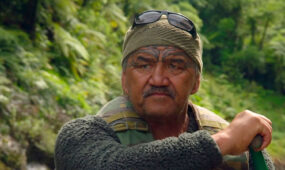Film review: David Stratton – A Cinematic Life
Film & TV
Documentaries about critics are rare — and possibly non-existent in Australia — which makes David Stratton: A Cinematic Life immediately noteworthy.

Stratton is probably one of the two most visible critics — of any art form — in Australia, thanks to his three decades of reviewing film on television with his fellow critic Margaret Pomeranz on At the Movies and The Movie Show.
But Stratton’s celebrity, courtesy of the cult appeal of his on-screen sparring with Pomeranz on SBS and the ABC for all those years, was preceded by his 17 years as director of the Sydney Film Festival and his work as a film critic for Variety, in which he indefatigably championed Australian film for an international readership.
Stratton’s obsession with the Australian film business stretches from his first exposure to Chips Rafferty in The Overlanders (1946) as a seven-year-old in his native England to the present. This provides the documentary with its conceit: scenes from classic Australian films are used to illustrate Stratton’s own long career in film.
Stratton, now 77, both narrates and appears in the 97-minute documentary as he tells the intertwining stories of his own and the Australian film industry’s fortunes. Directed by Sally Aitken, he tells of his arrival here in 1963 and his first trip to the Australian outback.
Stratton’s recollections of confronting raw Australian characteristics are illustrated with chilling scenes from Canadian director Ted Kotcheff’s terrifying Wake in Fright. (The 1971 film has proved itself never not relevant, considering last week’s news story of yet another foreign backpacker’s outback ordeal.)
Kotcheff is one of the many talking heads in the documentary who genially recount fascinating stories about the making of many of our best-known films. The roll call of luminaries includes directors George Miller, Gillian Armstrong, Bruce Beresford, Fred Schepisi, Paul Cox and Ana Kokkinos, among many others.
PJ Hogan and Jocelyn Moorhouse talk about the making of Muriel’s Wedding (1994) while Stratton uses the film to explain how he, like Muriel, always felt like an outsider — even in his own family, prosperous grocers by trade, who had zero interest in film.
Anyone interested in the history of Australian film will enjoy this documentary for the clips and discussion that follow the trajectory of the local film business since Australia produced the world’s first known feature film, The Story of the Kelly Gang (1906).
Stratton acts as an excellent guide to this history, though his excursions into his own life story do begin to feel laboured. His recollection of his distanced childhood relationship with his own father is illustrated with scenes from Careful, He Might Hear You (1983), which feels like a stretch.
The directors and actors featured in this documentary almost all talk about their own films, rather than Stratton’s involvement in the film industry. Nicole Kidman, Bryan Brown, Jack Thompson, Jacki Weaver and Sigrid Thornton do have nice things to say about Stratton, but these grabs come across a little like those Channel 9 fillers, 20 to One, in which celebrities offer their opinions on any topic thrown at them.
This is not surprising, given that it’s difficult to make someone who has spent most of his life in a darkened cinema sound interesting (Stratton estimates he has seen 25,000 films). While his passion for film is well documented in the film, and his vast knowledge is self-evident, Stratton the man remains elusive.
For a film dedicated to a critic, this documentary has virtually nothing to say about the role and responsibilities of a critic. How Stratton approaches his reviews, his style of reviewing, the quality of his reviews, or how criticism is changing in an era when anyone can broadcast their opinions of a work of art, is barely acknowledged.
The parade of celebrity guests in the documentary seem to provide the foregone conclusion that he is a great reviewer. Margaret Pomeranz, tellingly perhaps, is the only other critic featured in the documentary and she declares him a “national treasure”.
But it’s not all hagiography. Geoffrey Wright, the director of Romper Stomper (1992), still loathes Stratton for his review of the film about neo-Nazis in which he declared it was “dangerous”, refused to give it a rating and suggested the negative should be burned.
In separate clips, Wright and Stratton recall how Wright threw a glass of wine over him at a reception at the Venice Film Festival. Wright says he’d do the same thing all over again — but next time he’d use red wine.

Get InReview in your inbox – free each Saturday. Local arts and culture – covered.
Thanks for signing up to the InReview newsletter.
Stratton and Pomeranz recall this incident together and Stratton appears peeved and nonplussed as to why Wright would have reacted in such a way. For a man lauded for his analytical skills, he appears to have little understanding on how criticism affects, and possibly shapes, an artist. It’s up to Pomeranz to explain to him the emotional complexities of the relationship between those whose career is making art and those whose career is commenting on it.
This article was first published on Daily Review.
Support local arts journalism
Your support will help us continue the important work of InReview in publishing free professional journalism that celebrates, interrogates and amplifies arts and culture in South Australia.
Donate Here





Comments
Show comments Hide comments